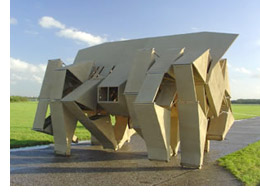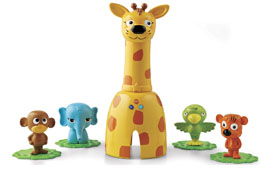Monday, September 29th, 2008
Last week I attended a conference called the Sandbox Summit in New York City. The Summit was a day long event with many noteworthy speakers who are software and content creators, child development experts, and reviewers of technology toys for children. The event’s main theme? The power of play and its ability to help facilitate learning.
Opening
During the opening keynote, speaker Andy Berndt, managing director of Google’s Creative Lab, described how almost everyone can remember a favorite toy when they were young (link to audio of presentation.) Andy shared his favorite play activity, that being a creative experience which involved the process of inventing new bicycles. When he was a child, what he did was take apart many different bicycles, and because bicycle parts for the most part are standardized in terms of their bolt sizes and screws used to make them, he was able to recombine different bicycle parts into unique, unusual, and exciting combinations. One could say that Andy’s open ended experimentation with bicycle parts was on par with play experiences found in Legos, K’Nex, Lincoln Logs, Erector Sets, and the like. What is it about Andy’s creative experience that can lead to insights on how best to help facilitate a love of learning? Read on.
The Importance of Play and its Relationship to Learning
The next speaker who I thought did a fantastic job of providing an overview on the importance of play and the learning opportunities that come from play was Nancy Schulman, the director of the 92nd Street Y Nursery School in New York City (link to audio of presentation.) Nancy shared with the audience that one of the best things about her job for the last 18 years was the wonderful opportunity to watch young children play. With that experience she has learned a great deal about the benefits of play not just for preschoolers, but for all ages.
Nancy expressed that educators, psychologists, and even the American Academy of Pediatrics have great concerns today about the quality of children’s play, how children play, and the quantity of time children play. Parents on the other hand express a lot of concern around wanting their children prepared for success at a very early age. Through her work, Nancy speaks with many parents. One of the greatest anxieties she hears from parents is that they want to be sure their child has every advantage, making sure that before they’re five years old they’ve mastered a second language, mastered every sport they might possibly play, and excel at playing a musical instrument as well. While child professionals are encouraging more open ended play in a child’s life, sadly most parents aren’t paying much attention to these recommendations.
When Nancy was asked “What types of skills do kids learn through play? And why is that meaningful in terms of a child’s lifelong appreciation for learning or confidence in their ability to learn?” she responded first with a quote from child development expert David Elkind of Tufts University:
“Play is not a luxury, but rather a crucial dynamic of healthy, physical, intellectual, social, and emotional development at all ages.”
Nancy then discussed each of these developmental benefits and how child initiated play can lay the foundation for learning:
- Social – “Through play, children learn to interact with others. Play prepares children for morale reasoning. They figure out how to resolve a problem with a friend independently.”
- Intellectual – “They learn to recognize and solve problems. Children get that feeling of mastery that only comes from when they’re challenged but not frustrated at the same time. In academic areas, play is linked to creativity, imagination, and problem solving skills and it lays the groundwork for successful learning experiences in reading, writing, math, and science. If you think about what children do when they play, it’s very language rich. They are interacting with words and language all the time and learning communication skills.”
- Physical – “In terms of physical development, they can develop through play fine motor skills, gross motor skills, overall strength and integration of their muscles, their brains, and their nerves. It sets apart a start in their lives for healthy living and fitness, which of course, can counter obesity as well.”
- Emotional – “Play is Joyful. It is probably one of the greatest underpinnings for later adult happiness. It can’t be underestimated how much happiness and joy have in terms of learning as well.”
Survey of Kids Opinions about Play
The next speaker who offered some additional insight into what kids think about their favorite play objects was Peter Shafer, Vice President of Harris Interactive (link to audio of presentation.) Peter shared with the audience a recent online survey conducted in collaboration with the Sandbox Summit of 1, 353 US children ages 8 to 18.
There was a wealth of data to digest in this presentation that spoke to tween and teen toy preferences as well as video games and digital toy products. In general I found this data interesting in that it backs up many gut assumptions about what different age groups prefer in their toy playing experiences.
One observation, it appears the definition of a “toy” was intentionally left undefined in this survey. Did survey respondents think a toy was a traditional toy, a technology toy, or maybe even a video game? Parts of the survey appeared to suggest what the differentiation of a toy was while other questions were not as clear.
Here are a few pieces of data I found interesting to pull out of the Harris Interactive Sandbox Summit survey press release:
“How much do you agree or disagree with the following?”
Summary of Strongly/Somewhat Agree
| Â |
8-12 Year Olds |
13-18 Year Olds |
||
|
Males |
Females |
Males |
Females |
|
|
% |
% |
% |
% |
|
|
The most important part of a toy is that it is entertaining. |
86 |
83 |
72 |
69 |
|
Toys that involve technology, like video and computer games and handheld games or toys, are more fun than other toys. |
84 |
69 |
71 |
53 |
|
I enjoy toys or games that make me think. |
82 |
79 |
73 |
77 |
|
I would rather have a toy or game that is fun to play even if it does not help me learn. |
75 |
67 |
61 |
48 |
|
Toys are important in our lives to help us learn. |
67 |
63 |
60 |
53 |
I call your attention to a couple of specific items from the survey (colored in light blue.) For the 8 to 12 age group the most popular response for a toy product was that it should be “entertaining” whereas with the 13 to 18 year old group there is a great appeal in products that “make me think”.
Best Practices for Developing Playful Products
After the Harris Interactive presentation, Carly Shuler, a Cooney Fellow from Sesame Workshop’s Joan Ganz Cooney Center and educational technologist Carla Engelbrecht Fisher delivered a presentation called “Fun Follows Function: Ten Tips for Developing Quality Toys”. Below I briefly outline each tip, but you can download an audio recording or download a PDF copy of the PowerPoint presentation here.
- Bridge the gap between industry and academia – This first tip strongly suggests the benefit of bringing together multidisciplinary teams (child development experts, content experts, pedagogy experts, etc.) This first tip is one my company follows frequently. There’s a great paper by Brian Winn and Carrie Heeter, both from Michigan State University, about the important balance needed (and often the necessary heated debate) that comes from working collaboratively with multidisciplinary teams. A copy of this paper can be downloaded here.)
- Incorporate research and testing in your product development and discovery process – Any amount of testing, large or small, will have a beneficial impact on your product’s development. From informal focus and user testing groups to serious product research efforts there’s a research approach that can fit your budget.
- Track what users do in your product – There’s lots to be learned from watching how your target audience interacts with your product either informally or through data collection. Spend time analyzing what you find.
- Read some research – Become familiar with the basics of developmental psychology for the specific age group your developing for. Doing this will help avoid reinventing the wheel. A handout was shared at the conference with many great places to jump start your research reading list. A copy of this reading list can be downloaded here.
- Become an observer – Watch kids at play in the real world or even on YouTube (a cool suggestion offered by Carla). Watch how kids interact with products, visit playgrounds, schools, toy stores. Note what’s on the shelf and where it’s located. Also be aware of what’s on sale, it may provide a tip for what’s not selling.
- Break the traditional model of one child per screen – Think outside tradition single player models. Think multiple players, or better yet, how can you actively encourage inter-generational participation! Think outside the keyboard box, consider alternative input devices (dance pads, guitars, balance boards.) Consider how you could combine virtual and physical worlds in new ways (like the success Webkins achieved with dual play patterns online and offline.)
- Leverage consumer market trends for learning – Consider user generated content, online video, or casual game approaches. Be aware of these every changing trends and you just might find one that will greatly elevate the success of your product.
- Go beyond the “3 R’s” – Think 21st Century Skills: Creativity, critical thinking, collaboration, communication. For more on 21st Century Learning Skills, download this presentation from the May, 2008 Joan Ganz Cooney Center’s first annual symposium.
- Become familiar with various game mechanics – There are many different game mechanics that could increase interest and engagement in your product. Some old mechanics can be made new again with the newest technologies.
- Tap into your own childhood – Everyone has childhood experiences that can help shape your product for the better. Tap into your own experiences as well as those around you.
Note about Virtual Worlds
Kids and virtual worlds was touched on a few times throughout the day but I thought the following statement was worth calling out in its own section. Peter Shafer of Harris Interactive indicated that we will see explosive growth in the area of virtual worlds specifically for kids. The numbers cited were that there are about 80 virtual world destinations for kids today and by the end of 2010 there will be more than 150 virtual worlds to choose from. For a current list of virtual worlds available, I have the following link to share.
Takeaway
So what’s the key take away for developers, innovators and creators of playful learning products for kids, whether traditional or technological? Here’s the secret sauce that was repeated over an over again through words and through examples:
- Make the play experience as open ended as possible. Think about opportunities for vast exploration, not a limited path of play. Include opportunities to fail as well as ones to succeed. Let each child develop their own unique path to play, one that is customizable enough that it appeals to a single user and flexible enough that multiple users can find their own unique approach.
- Bring together a variety of child experts.
- Become familiar with research.
- Watch your audience, get familiar with your audience, test with your audience.
- Try something new! Break the habit of relying on the same old technology and user input solutions.
- Think 21st Century Skills
Nancy Schulman also offered this sage advice:
“If your child can’t play with a toy in at least three different ways, leave it behind.”
And one last thought for making the next greatest learning toy, digital or otherwise… Think bicycle parts.
Referenced Products and Videos
Here’s a list of digital products and online YouTube videos that were referenced throughout the Summit.
| Apple Ad | Andy Berndt from Google reference this old Apple ad called “Industrial Revelation” that looked at computers and their power to significantly enhance learning empowerment |
| Dizzywood | Scott Arpajian’s latest virtual world environment. In Scott’s presentation, he touches on how schools are using Dizzywood to promote student diversity |
| Huru Humi | Mike Nakamura of Senario, demonstrates his company’s latest digital avatar toy that is designed to encourage self-discovery and social skills by using technology to spur real-life interaction among tweens and teens. |
| Kerpoof | Kerpoof is an empowering online creative tool for kids. |
| Kidthing | Kidthing CEO Larry Hitchcock presents his safe digital online environment which can be used for distributing entertainment and learning material |
| LeapFrog’s Learning Path | Jim Gray, Director of Learning for LeapFrog, discusses LeapFrog’s Learning Path, and online component to LeapFrog’s consumer products that lets parents see and shape a child’s learning. |
| Backyard FX – How to make Movie Rain | Erik Beck, who is a producer for NextNewNetworks develops an online low budget video show called Backyard FX. Erik’s work is wonderfully creative and the audience cheered his YouTube presentation on how to make “movie rain”. It was an excellent example of how best to combine a technology and creative vision. The example video is a must see! |
| Sabi Games | Margaret Johnson, CEO and Cofounder of Sabi Games, discussed her upcoming learning games release that is worth keeping an eye on. Stay tuned for more from Sabi in October. |
| Scratch | Mitchel Resnick’s online creativity and collaborative learning project called Scratch. For an interview with Mitchel about Scratch and his learning approach embedded throughout the product, click here. |
| Sesame Street | Makeda Mays Green discusses the newly relaunched preschool learning website at SesameStreet.org |


 This past week I was at Northwestern University to participate in a conference called
This past week I was at Northwestern University to participate in a conference called  The artwork developed by kinetic sculptor
The artwork developed by kinetic sculptor  Last year I
Last year I